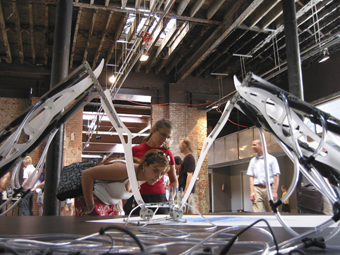Cutting out the middleman, Dr Frankenbott?
Kate Vickers on the ethics & future of bio-robotic art

Meart—The Semi Living Artist
photo Phil Gamblen
Meart—The Semi Living Artist
If nothing else, the coming of age of science could perhaps be measured by the level of popularised or folk science. This cultural maturation might be currently observable in the airing of spurious documentaries on commercial TV such as The Human Brain and the children’s program Backyard Science on the ABC. The translation of science into publicly accessible imagery has a cultural function. Towards this end an organization such as SymbioticA gains public relevancy. Certainly the credentials and funding bodies behind the project MEART—The Semi Living Artist are testament to this.
A small but interested crowd gathered at the ARTRAGE Bakery complex in Northbridge to see the last exhibition of MEART. The project was created by SymbioticA, The Art & Science Collaborative Research Lab, University of Western Australia in collaboration with the Dr Steve Potter Lab, Department of Biomedical Engineering, Georgia Institute of Technology in Atlanta; and the Ultrafutura Group.
In the gallery a platform supports a robotic arm holding a coloured pen. A collaborator from SymbioticA asks for an audience volunteer to have their portrait drawn by MEART. The subject’s image is recorded on a video camera in the gallery. The image, converted to a ‘stimulation map’ of 64 pixels (8×8), is sent via internet to Potter’s lab in Atlanta where, nestled in an incubator, a group of rat neurons are fed the electrical stimulus.
The audience in Northbridge WA watches a projection of alternating images: live feed images of the Atlanta lab, complete with bored looking lab technician; photos of the incubator; micro images of said rat neurons; and a graph figuring their activity. The robotic arm, now connected via the internet to the activity of the biological material begins to move the pen across a piece of paper affixed to the platform beneath it.
At one minute intervals an image of the drawing in progress is captured. This data is used to create a feedback loop whereby the frequency of the electrical stimulation sent to the neurons is determined by a pixel grid of error values. These figures are determined by comparing the current drawing to the first image captured. A computer program analyses the signals received from the stimulated neurons, feeding the data to the robotic arm.
The Northbridge audience witnesses the production of a crosshatch-like pattern similar to the records of earlier exhibitions of MEART. Over the last 5 years MEART has been shown at ARS Electronica, Biennale of Electronic Art Perth (BEAP), Artbots in New York, the Australian Centre for the Moving Image (ACMI) and at the 1st Moscow Biennale for Contemporary ARTS. In the Moscow exhibition Malevich’s “Black Square” was used to initiate MEART’s activity.
‘MEART’ derives from the type of incubator used (multielectrode array) and the word ‘art’.’ This research and development project is centred on questions of creativity and biological technologies. The researchers are interested in the possibility of emergent behaviour, of creating an ‘artist’ rather than an ‘artwork.’ At the Northbridge event, collaborator Guy Ben-Ary comments that the project is a ‘cultural experiment.’ It is highly significant that MEART is a durational work: existing only while the audience is present. Perhaps it is through the audience that behaviour emerges that is linked to and yet independent of the project collaborators’ intentions.
Another of the project’s aims is to raise ethical questions related to biological technologies. While artists within academic institutions, particularly in postgraduate programs, have had to consider ethical issues prior to project commencement, the public involvement in these concerns seems to be limited to issues of political currency—such as abortion or human stem cell research. Perhaps the contemporary question of ‘folk Zen’ might be: if an ethical question is raised and nobody sees it and nobody hears it, was it really raised? Certainly potential studies of the metaphors MEART creates may be fruitful in this regard.
Two of MEART’s collaborators, Philip Gamblen and Guy Ben-Ary, have been invited to reside as research fellows in the Steve Potter Lab. The Lab is involved in neuro-engineering, developing neuroscience technologies for studying learning and memory in vitro. We await the ‘next generation’ of MEART. The question is: will the rats and the gallery audience be ready for it?
MEART—The Semi Living Artist, SymbioticA, The Art & Science Collaborative Research Lab, The Bakery, ARTRAGE Complex, Northbridge, Dec 20, 2005
RealTime issue #71 Feb-March 2006 pg. 25






